NO. |
BOOK TITLE |
AUTHOR |
PAGE |
SIZE (inch) |
EDITION |
YEAR |
001 |
HEAD PROP studies 2013-2016 |
TOMIHIRO KONO |
232 |
8 X 8 |
500 |
2017 |
‘The Shaping of New Head Design Field’
Tomihiro Kono’s distinctive creations, called head props, are the subject of this fascinating book. Already established in his successful international career as a session hair stylist, since 2013 Tomihiro has ventured into new territory with his head props. This book documents the path and inspirations he has followed in his innovative efforts to make decorative designs for the human head, and gives a sense of the uncompromising approach he takes in his work. Filled with detailed sketches, development models, and finished concepts, it makes clear that Tomihiro not only attempts to produce visually striking head designs, but also focuses on functionality in the beauty of form.
頭のデザイン表現の可能性を模索し続けてきた河野にとってオリジナリティのある head prop design を創り出すことは、純粋に作品制作に対する情熱であり、表現に対する飽くなき探究心の表れでもある。約20年のキャリアの中で特に2013年から2016年まで作品に焦点が当てられて制作された本は、新しいヘッドデザインが生み出されるまでの革新的な旅を、河野富広が辿った洞察と道筋と共に明確に記録がなされている。
ヘアスタイリスト・ヘッドプロップアーティストとして、パリコレクションでのファッションショーや数々のVOGUEの表紙を飾るなど、国際的なキャリアを築き上げることが出来たのは、視覚的に印象に残るヘッドデザインを造り出そうとしただけでなく、美しさの中に機能性を重視したデザインを新たに生み出したことにあると言えるだろう。 一見華やかなヘアスタイリストの仕事の裏側、特にアイデアを形にするまでの彼の思考を見られる機会は意外と少なく、世の中に出るデザインの背景には、知られざる様々なアイデアと試行錯誤の積み重ねがある。河野富広のクリエーションのアイデアと思考のプロセス、コンセプトの探求などを含め、ヘッドプロップデザインをアカデミックな視点からまとめたパーソナルでドキュメンタリーな一冊になっている。
 |
 |
 |
 |
 |
 |
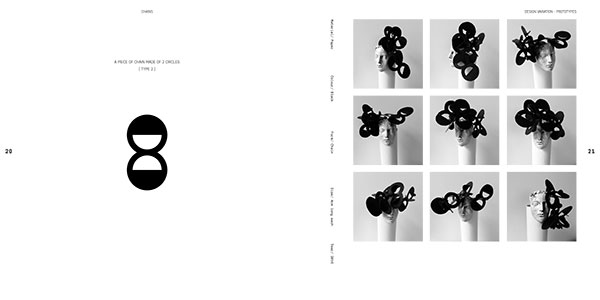 |
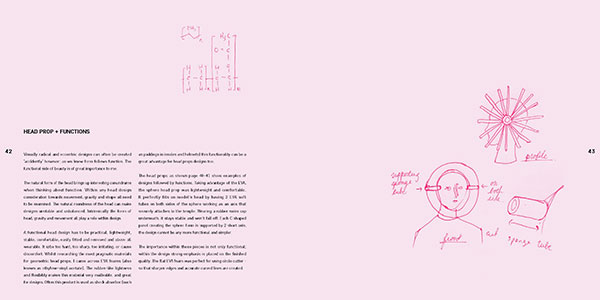 |
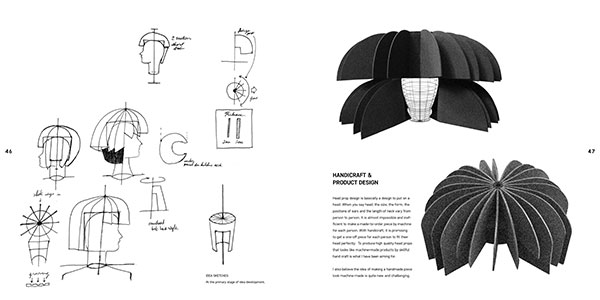 |
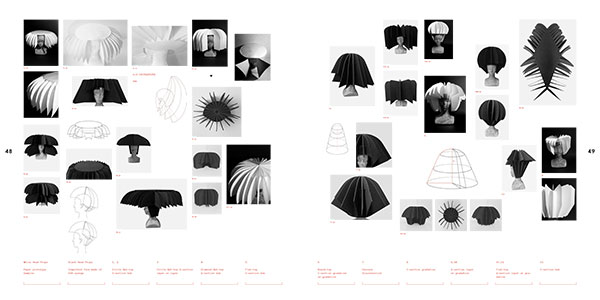 |
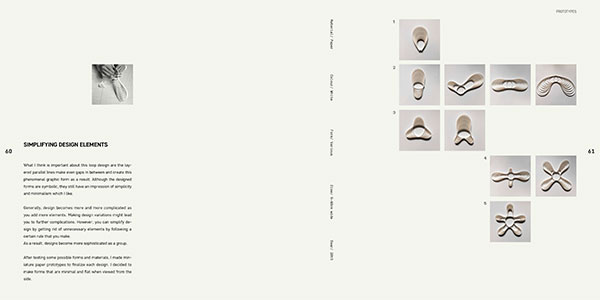 |
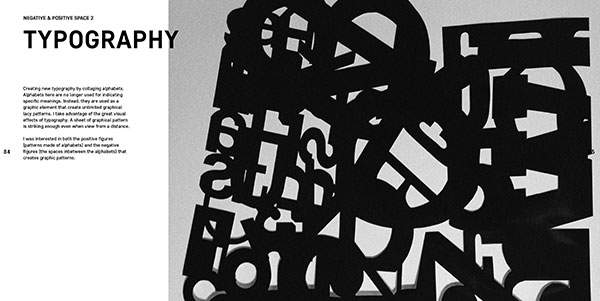 |
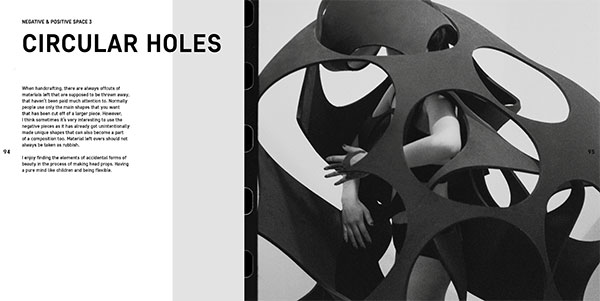 |
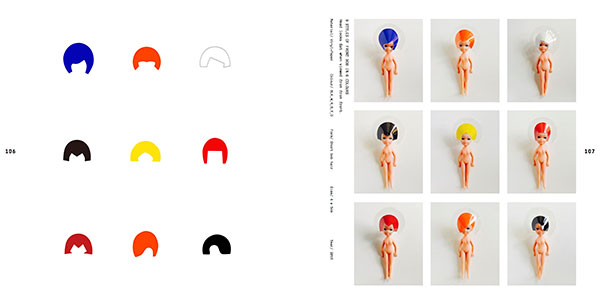 |
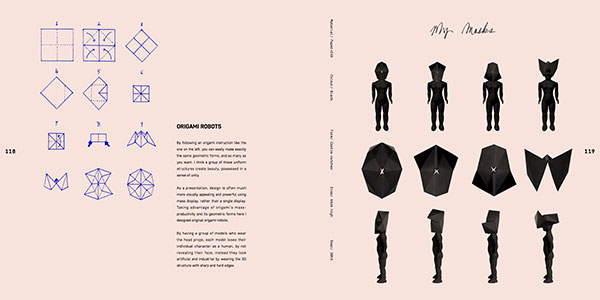 |
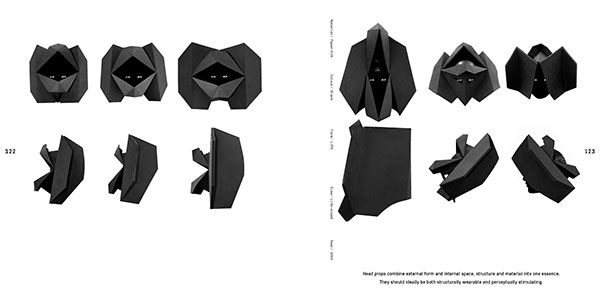 |
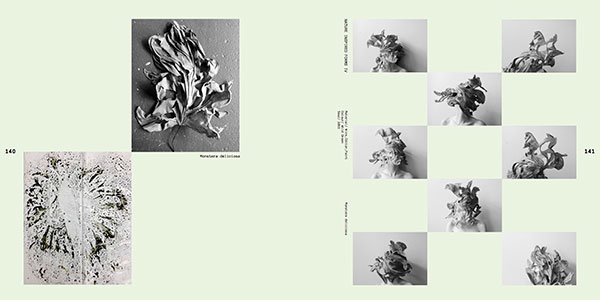 |
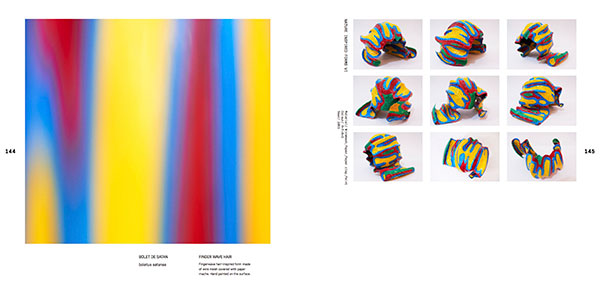 |
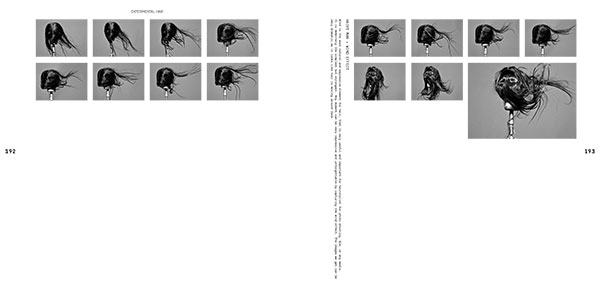 |
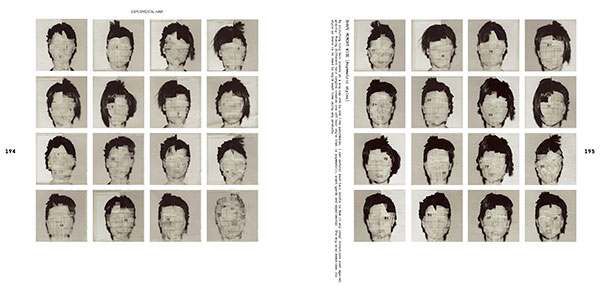 |
HEAD PROP
by Tomihiro Kono
500 copies –8x8 inch – 232 pages - Soft cover
+10 limited signed copy editions (one-off cover)
ISBN 978-0-9986205-1
$50 + shipping [we ship worldwide]
*go to shop for purchase
Signed copies also available.
International Distributor: IDEABOOKS.nl
Introduction of the book:
For the first-time, hair and head prop artist Tomihiro Kono reveals the creative process behind his collections produced between 2013-2016, including never seen before concepts, and designs.
Tomihiro likens the art of hairdressing to that of a sculptor; one who shapes, moulds, or fashions, especially with artistry or precision. Learning to perfect techniques, style, and control, has been fundamental in Tomihiro's process. His interests go beyond cutting and styling hair; they delve further into formative, and sculptural head art.
Tomihiro began his career in a traditional Japanese salon in Tokyo, where he spent 10 years mastering skills in classical Japanese hair cutting. In 2007, he moved to London and branched into session styling. His passion, and inventiveness soon lead him to work beyond hair.
Exploring more creative designs, Tomihiro developed a new field of ‘HEAD PROPS’, breaking new ground as a hair stylist, and head props artist.
Tomihiro describes designing head props like an act, creating original characters by adding visual impact. To Tomihiro, this is one of the best personal expressions, and creativity as an artist. In the beginning of Tomihiro’s career, as a head prop artist, his designs had a strong influence from European culture and the idea of ‘Assemblage art’; 3 dimensional artistic compositions (3-D collage). Using objects he found beauty in, such as feathers, metals, nails, studs, leather, etc, Tomihiro’sstyle was described as organic, dark, romantic, gothic and religious. During this time, Tomihiro gathered inspiration from found materials and objects, creating one off pieces so handcrafted and bespoke in both nature and design, it was impossible to replicate the same piece twice.
A change within Tomihiro’s approach to head props came about in 2013, when Tomihiro relocated from London to New York. Previously obsessed with materials and textures within his pieces, Tomihiro’s designs began to move in a different direction, shifting previous inspirations to new beginnings -beauty in form. It was this shift that lead to more minimal and conceptual designs within Tomihiro’s work.
This change was not only evident in Tomihiro’s creations; its influence began to change his entire working process. Slowly moving away from the emotional and aesthetic process, Tomihiro started adopting methodical design and concepts. Focusing more on structure, function, and form, soon Tomihiro’s ideas began to take a graphic design path; functional form became central to design.
This methodical path ran parallel with technical lead designs guiding Tomihiro away from an organic approach to one that become mathematical; constructing and developing ideas through sequences, and problem solving.
Recording the experimental work during the shift process, Head Studies reveals Tomihiro’s craftsmanship, research, production process, design, and developments. His unique approach to head design resulted in original designs featured in head studies, and beyond, affirming Tomihiro as a pioneering, and influential artist.
Head Studies is composed of three chapters; Form studies, Material studies, and Hair and wig studies. Each chapter exclusively captures Tomihiro’s different approach to head prop designs. Form studies looks at variations in form using two-dimensional materials. Expanding designs based on visual effects, design elements, and principles such as optical art, foreground, background, typography, paralleled lines, solid of revolution, etc.
Material studies is a natural progression of form studies, and follows Tomihiro’s experiments with different materials and the influence of these within his designs.
Tomihiro fuses all these elements, whilst honing in one of his favorite materials, hair within Hair and wig Studies. Pushing his ideas beyond boundaries, this final chapter encompasses his destruction of the old and creation of the new, leaving his head designs distinctive beyond compare.
in Japanese:
従来のヘアスタイリストの分野を越え、髪の毛のアレンジだけに留まらず、頭全体の装飾・造形美を追求する Hair & Head Prop Artist という職業が存在する。河野富広が2013-16の間に制作したヘッドプロップの数々とその思考のプロセスを集約した作品集『HEAD PROP studies 2013-2016』が 2017年4月1日アメリカで出版・発売された。本展示会はその出版を記念した東京での初のエキシビションとなる。恵比寿のbookshop POSTと連動しながら、二つのギャラリーで完結するプレゼンテーションをおこなう。
美容師としてそのキャリアをスタートし、ヘアスタイリストとして世界で活躍する河野富広は、髪の表現の延長線上に《ヘッドプロップ》という新たなジャンルを確立し、《頭のデザイン》の表現の可能性を試すべく、独自の道を切り開いてきた。河野にとってオリジナリティのあるhead prop designを創り出すことは、純粋に作品制作に対する情熱であり、表現に対する飽くなき探究心の表れでもある。
Gallery (Place) by methodでのエキシビションは、作品集『HEAD PROP studies 2013-2016』の本のデザイン・コンセプトである、THE STUDY OF TYPES (デザインのバリエーションや形の種類)を並べることで見えてくる可能性をポスターとして展示。デザインを一体作るだけでは見えてこない、展開させていくことの可能性を探る。
About book HEAD PROP studies 2013-2016
この本は 河野富広の作品作りに対しての妥協のないアプローチを通して、2013-2016の間に試行錯誤して製作されたヘッドプロップデザインを独自の視点で記録したものです。この間、河野は、自身のクリエーションにおいて、視覚的に印象に残る新しいヘッド・プロップデザインを作り出そうとし、また、美しいだけでなく実際のショーなどに対応できる機能性を重視した、バリエーションの出せるデザインを生み出そうと試みました。
Introduction
これはHair & Head prop artist 河野富広が2013-16の間に制作したヘッドプロップの数々とその思考のプロセスを集約した作品集である。Hair & Head prop artist という肩書は河野自身が生み出したものであり、従来のヘアスタイリストの分野を越えるべく、髪の毛のアレンジだけに留まらず、頭全体の装飾・造形美を追求する職業のことである。
ヘアデザインの新境地を求めて、ヘッドプロップという分野を開拓したことに始まり、「頭」の表現の可能性に対する純粋な探究心により、様々なTrial & Error (試行錯誤)を積み重ねてきた。河野にとって《頭のデザイン》とは、装飾的なヘア・アクセサリーを作るという以上に、視覚的なインパクトや、合わせる服との化学反応を狙ったものであり、強いイメージ(像)を生み出そうとする試みである。非現実的でファンタジーなものへの憧れや、作り出される新鮮な存在感、美しさがその魅力である。
河野がヘッドプロップを制作し始めたのが2007年頃、ロンドンに渡った時からである。当初は、様々な素材からインスピレーションを受けて、その組み合わせで形づくりながらデザインしたり、ヘッドマネキンの上で試行錯誤しながら、アッサンブラージュ的な手法で制作し始めた。このやり方はヘアスタイリストの間でも割にベーシックな考え方・作り方である。
河野の制作方法が、それまでの〈頭の形に沿うデザイン〉から大きく変わったのが2014年。キネティック・アート、連続する形、立体的に見える平面、など、一つの原理やコンセプトからデザインを展開させていく方法をとるようになった。
それ以前に制作したヘッドプロップに比べ、デザイン性と機能性を合わせ持った《フォルムの美しさ》に重点をおくようになった。装飾的な要素はできるだけ取りはらい、作られるものはより記号的になっていったが、そこに一貫してあったのは、抽象的でありながらもヘアスタイルを表現しているということ、または消すことできない頭の存在をぼかしたり存在しないように見せたりするという視覚的効果を生み出す方法を探ること。それはヘッドプロップを単なる髪の装飾と捉えるのではなく、頭自体の存在を一新するための装着物と捉えている。
まず紙のプロトタイプを制作することから始めるという、デザインをあえて平面から起こすという手法は、そもそも3Dである頭を扱うヘアスタイリストの方法論にはないものであるが、思いがけないデザインを探る一つの方法として取り入れていった。
その実験的な試みは、頭の形状に沿うようにデザインするより思いもよらないデザインに導いてくれることがある。最終的なデザインに到達するためには《思考の遊び》が必要で、その過程に半ば偶発的に生まれるフォルムは興味深い。
現実的にショーなどで使うということを念頭においた時、ユニークな形態と意外な実用性を兼ね備えたプロダクトを制作しなければならない。ここでいう意外な実用性とは、頭に乗せるという制約のことであり、その中で重量やサイズ、素材などを厳選しなければならないため、非現実的な重さの素材を使うことはできない。
そもそもヘアカットは一種の彫刻である。美容師としてサロンワークをしていた時は、「髪の毛を切る=マイナスにしていく」作業を突き詰めることを追究していたが、それとは反してゼロから新しいものを作り出していく作業を主に行っていた2013-2016年の色々なtrialを重ねた独自のクリエーションに対する実験とプロセスがこの本の中には収められている。

「拡張する髪」 髪とアタシ
Hair & Head prop artist 河野富広。
美容師からキャリアをスタートさせ、セッションスタイリスト、ヘアアンドヘッドプロップアーティストになった彼の目に、「髪」はどう映っているのだろうか。
河野富広のX軸は髪の探求に伸びていき、
Y軸はキャリアの進化として伸びていく。
この時間、この瞬間にも、彼は髪のイメージを拡張し、ひとつの運動体となっているのだ。
作品たちは、幾何学、非重力、連鎖、非対称。
まるで日本庭園を見ているような、
JAZZを聴いているような、
ひとつひとつに意味を孕みながらも、
明確なメッセージは隠された代物。
髪の既成概念を、蓄積されたロジックで越境してくる。
髪が、拡張されているのだ。
髪を「立体物」として捉え、髪を「髪」と捉えない。
そこにヘッドプロップというブルーオーシャンが
見えた気がした。
美容文藝誌 髪とアタシ
編集長 ミネシンゴ
Vogue ITALIA>
April 7, 2017 7:00 AM
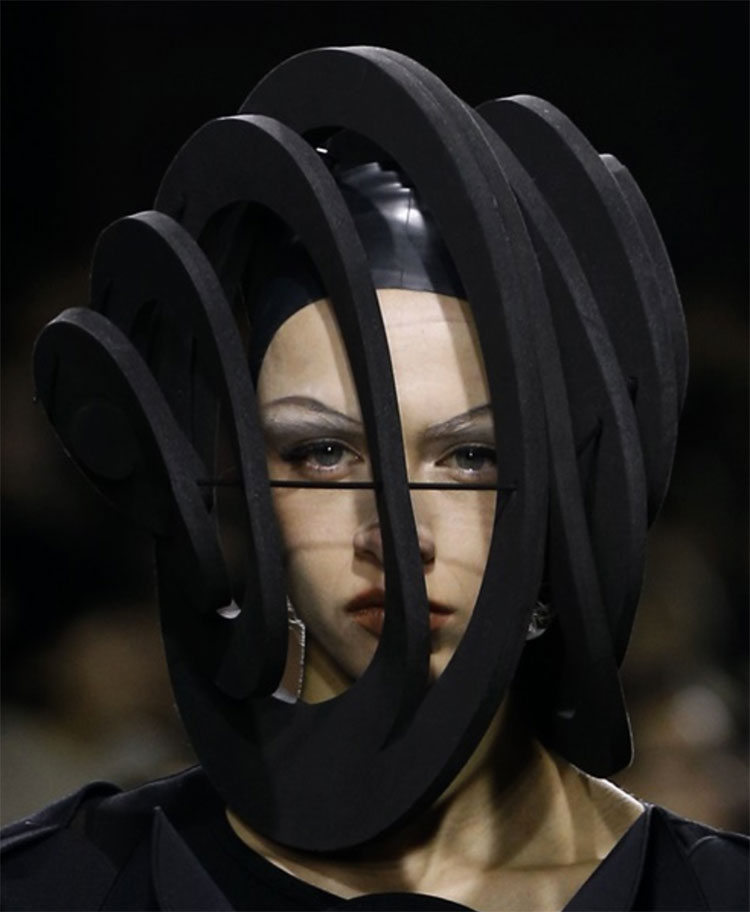
Junya Watanabe AW 2016 ©Getty
Head Prop marks the first volume dedicated to the work of Tomihiro Kono, the visionary Hair and Head Prop Artist who designed the sculptural headpieces for Junya Watanabe.
The 232-page volume includes photographs, sketches and texts documenting and unveiling the creative process behind Tomihiro Kono’s work through famous creations and previously unseen prototypes produced over the period between 2013 and 2016.
Japanese-born, New York-based Tomihiro Kono is one of the most visionary hair stylists of his generation and over the last ten years has made his name known in the industry thanks to major editorial collaborations with prestigious publications, including Vogue Italia.
Distributed by IDEABOOKS, Head Prop by Tomihiro Kono will be presented today April 7th at Canal Street Market, Soho, New York. Timed with the book launch, limited edition posters featuring blown-up renditions of some of the artist’s most representative creations will also be available for sale.
Next August 2017 Tomihiro Kono will be celebrated in his native Japan with his own exhibition at the Place by Method gallery in Tokyo.
Check out our gallery for some images from Tomihiro Kono’s Head Prop exclusively for Vogue Italia.
Vogue PARIS> 04 April 2017
By la rédaction, translated by Holly Lambert and Isabelle Johnson
From visionary make-up to incredible hair and skin-saving secrets, honor beauty in all its forms in these seven books you need to add to your library.
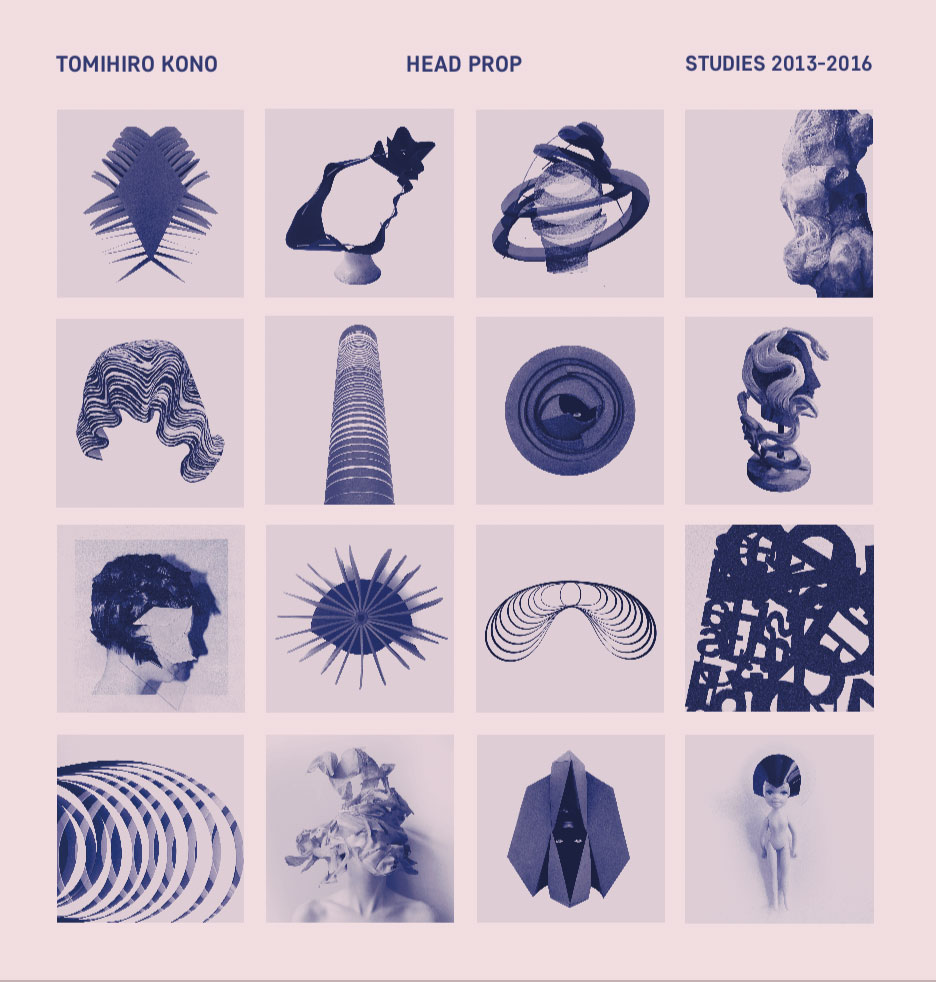
Head Prop: Studies 2013-2016 by Tomihiro Kono
After having illustrated his one-of-a-kind aesthetic, punctuated with Japanese influences and surrealist graphics at the Junya Watanabe shows, Tomihiro Kono shows the creative process behind some of his most beautiful hair effects in a new book. Head Prop: Studies 2013-2016 explores three main points: the shape, materials (like string, rubber and glass) and the surprising end hair result, which is often a 3D structure. A book of research and ideas from 2013 to 2016 illustrated in just one book, it shows the hair’s limitless potential.
DAZED & CONFUSED> 31March 2017
Junya Watanabe’s hair guy, Tomihiro Kono, on his new book
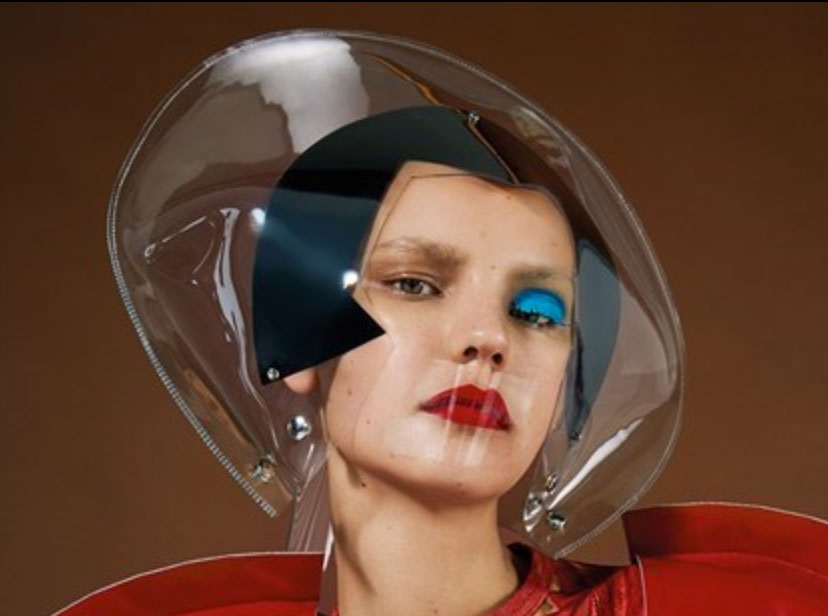
Junya Watanabe SS 2015© ︎Nicolas Coulomb
In an exclusive first look at his upcoming book, the master of hair and head props reveals how he carved out his own unique path in fashion
“It requires hard work to create something original,” says Japanese hairstylist and head prop artist Tomihiro Kono. And he should know, having carved out a career within the fashion industry quite unlike any other. Curiosity lies at the heart of everything Kono does: as a young boy growing up in a small mountain village in southern Ehime, he spent his days exploring and cultivating an enduring love of natural forms. As a teenager, he discovered punk music and fashion, burying himself in British magazines and, after finishing school he moved to Tokyo, securing a job in a traditional Japanese hair salon.
“To create the traditional Geisha style we had to follow rigid step-by-step instructions using special wooden tools,” Kono tells us. At first, he felt unconfident in his ability to master such intricate skills, he explains, but this all changed when he met his hairdressing teacher. “He was a master of classical Japanese hairdressing, but I found out that he had developed his own techniques and style just by observing and studying hair. I was very impressed. After that, I realised I could teach myself anything, and even create my own equipment for hairstyling.”
Kono soon began designing his own unique styles, expanding into sculptural head props in 2007, the same year he moved to London. There he gained acclaim as a session stylist for publications like Dazed and i-D, using his brooding bespoke headpieces, crafted from found objects such as metal and feathers, to further enliven shoots. Since then, Kono has established himself as the doyen of his trade, constantly pushing at the boundaries of hair and head styling.
“It’s quite hard to make something you’ve never seen as a hairstyling work, so I challenged myself to change how I create” – Tomihiro Kono
He has collaborated with some of fashion’s most prominent designers such as Jil Sander, Proenza Schouler and, most famously, Junya Watanabe (think: the lacquered, sumo-inspired hairpieces punctuating the menswear SS15 runway show or the brilliantly angular, 3D foam sculptures for AW15). Kono’s work for Watanabe highlights a purposeful shift in the artist’s previously romanticised aesthetic, which occurred after his relocation to New York in 2013. “It’s quite hard to make something you’ve never seen as a hairstyling work, so I challenged myself to change how I create; to apply a mathematical method whereby the designs became more functional and size-adjustable, which is practical for fashion shows,” he explains.
Refining this new, more logical approach required three years of extensive research and experimentation, all of which forms the focus of Kono’s brand new book, Head Prop: Studies 2013-2016, a fascinating glimpse into the inner-workings of his extraordinary imagination and technically skilled practice. The publication is divided into three sections, each fabulously illustrated with infographics, diagrams, sketches and photo grids. The first focuses on forms, shedding light on the ways in which Kono uses 2D shapes, from curved lines to typography, to conjure elegant, wearable 3D artworks. The second explores materials, showcasing creations made from rope, beer bottles, rubber tubes, you name it – there are even beards sculpted from iron sand. The third and final chapter focuses on experiments in hair, depicting some of the most beautiful, bizarre and meticulously constructed hairstyles you’re ever likely to see. Here, ahead of the book’s launch, we catch up with Kono to learn more about his multifarious practice and his advice for young creatives looking to forge their own unique paths.
What are the key ingredients of a great head prop?
Tomihiro Kono: Inspiration, ideas and research. The beauty of form. Unconventional material choices and combinations. Intelligence and elegance, and more importantly, making sure it’s not too heavy to be nice to your model! Then, of course, there’s originality. I like to create pieces that are unrealistic and extraordinary, but the head prop can also look like a hairstyle, which I find interesting and clever.
What should a head prop make the wearer feel?
Tomihiro Kono: A head prop is a piece of wearable art. So the wearer can be transformed into new character when they wear it.
You look at a lot of very varied references in your work. Who or what would you say has most inspired your practice?
Tomihiro Kono: I’m inspired by random things, but when I began to create more mathematical designs I would say I was inspired by Bauhaus, Dada, Fluxus art and American conceptual art. I was looking for more graphic elements. Ideas can be found anywhere, though – an interesting idea once occurred to me in an art materials shop.
“A head prop is a piece of wearable art...the wearer can be transformed into new character when they wear it” – Tomihiro Kono
How did you first come to collaborate with Junya Watanabe and what was the collaborative process like?
Tomihiro Kono: He first asked me to collaborate on a show when I was in Japan at the beginning of 2014. I sent him my initial proposal around one and a half to two months prior to the show. Junya never tells me what kind of clothes he’s working on for the coming collection, so I keep sending him ideas, without having any concept of the looks, until he picks what he thinks is the right one. I think he works this way because looking at clothes in the beginning might narrow my ideas, in a way. It’s fun seeing how the clothes and head props match each other perfectly in the final show!
What is your favourite material to work in and why?
Tomihiro Kono: Hair is the best material to play with because it’s difficult to control and I’m still learning a lot.
What prompted you to first branch out into making head props?
Tomihiro Kono: I think it was natural for me to start making head props when I began working as a session hair stylist in London. Fashion was in a very creative mood and people were shooting really interesting images, which I was really excited about. When hair stylists are working on editorials or shows – basically anything that will be photographed – our aim is to make a photograph look better, look phenomenal. I think hair and head prop design plays a very important role in fashion photography.
Why did you decide to compile this book?
Tomihiro Kono: Firstly, because I wanted to record a personal documentation of all my experiments – of the trials and errors of my creative process, because I’ve spent so much effort and time on it. Nowadays, what seems to be important is how you get a good result or archive quickly rather than how hard you’ve worked on it and the telling of the story behind it. Secondly, when you have so many ideas, you don’t have many opportunities to show them so the book seemed like a good way of doing that.
“Nowadays, what seems to be important is how you get a good result or archive quickly rather than how hard you’ve worked on it and the telling of the story behind it” – Tomihiro Kono
What do you hope readers will take away from it?
Tomihiro Kono: This book can be viewed as tool for sparking ideas and inspiration, not just for people working in fashion industry but for all creatives. It’s more about design and handicraft. I think the way I work is different from other hairstylists, so I hope it will prove inspiring for readers, not just now but in the future. It would be great if one day people came across secondhand copies of my book and realised that it’s still inspiring. I believe good designs are timeless.
What would your advice be for young artists looking to follow in your footsteps?
Tomihiro Kono: I’d like young artists to be real creatives and look for their originality slowly. I think it’s getting harder these days because it’s becoming more about how you show than what you make. I think you need both the sense and the techniques to be a real creative. If you want to be a hairstylist and make head props too, like me, firstly you need to learn about basic hairstyling, then tap your imagination and make some props to realise your ideas. This is how I started my career and I hope it’ll help others to find and own their creativity and pursue their dreams in fashion.
Head Prop by Tomihiro Kono is available from April 1, 2017, distributed by Idea Books, with a launch Friday April 7th from 6pm to 8pm, at OFFICE MAGAZINE newsstand at Canal Street Market, Canal Street Market 265, New York.
Tomihiro Kono, a hair stylist and head props creator, currently based in New York City, is best know for his outstanding work with designers such as Jil Sander and Junya Watanabe. His launch of his own book 'Head Prop' is a 'documentation of distinctive head prop work produced' by himself. Not only does Tomihiro produce 'visually striking head designs' but 'designs that focus on functionality in the beauty of form'. Kono has grown to become the master of a genre he created from himself.
words by Tilda Eliasson
I understand that your career started in Japan, where you worked as a hair stylist. But how did the idea of creating wigs and head props appear in the first place? What was the starting point for you?
I started my career as a hairdresser in Osaka, where I studied basic hair skills. Four years later I had gotten seriously obsessed with geometric haircut techniques and decided to master the method. I ended up working in a few different hair salons in Tokyo and acquired the best haircut skills. In 2017, when I branched into session styling, I moved to London. I started head props originally to satisfy my own creativity but I’ve always been obsessed with new hair and head creations. The act of hair styling and designing head props are, according to me, closely related to each other. They go hand in hand. Therefore, as a hairstylist it’s also my responsibility to keep working with hair designs in order to grow as a creative.
Was this all a part of your childhood dream or was it something you grew into as you got older?
When I was a young boy I wanted to become a veterinarian, which is quite different from what I do now. So I would definitely say that, as I got older, it was something I grew into loving. Even during the beginning of my career as a hairdresser I wasn’t dreaming about working abroad as a session stylist. I have just always been focused on doing the best I can and working hard. This is where it has taken me.
From a creative point of view, what was it like to grow up in Japan? Did the Japanese culture become a strong source of inspiration to you or was it just an influential cultural background?
Personally, I always got more inspired by the Western cultures. But when I moved to London I started to find more understanding of my own background. I think that the Japanese culture used to be something I would just take for granted.
After moving to London, I created a Geisha inspired portrait series. This is a classic example of our distinctive heritage, which I’m proud of.
Many successful people have said that having access to a big city is always an important part of your career. After living in both London and New York, two of the largest fashion capitals in the world, what do you think is the most significant difference between the designs you've produced in each city? In what way did the city affect your work?
I believe that my first choice of city was the right one. London has a great hair culture, especially the avant-garde style with its young creative- and punk influential spirit. It’s a city where people really appreciate originality. For me, working in London was a mix of crazy dark, romantic goth and experimental design, which was very satisfying from a creative aspect. But I do think that New York is the best place to establish oneself. I always try to adapt my work to the city I’m in and its current fashion trends. Therefore, since I moved to Manhattan, my work has been quite clean and modern.
The line between most creative subjects and art is often very blurred. Do you consider yourself to be an artist? If so, did you always feel like one or was there a significant moment in your life when you realised that you wanted to become one?
If there is one hairstylist that could be called an artist, I might be that person. But that is not how I see myself. However if I could choose, I would much rather be the only one than the best one.
By being involved in the fashion industry, you are constantly surrounded by the idea of beauty and how it should be presented, but in what and where do you personally find beauty in the world?
Personally I find beauty in the world of nature, music and old Japanese films - which I like the aesthetics in.
Working with craftsmanship and creating each design by hand must be very creativity challenging from time to time. What is currently your biggest source of inspiration? When you lose track, where do you go to find it?
At the moment, my source of inspiration comes from wigmakers around the world. That is the subject I will build my new project around. Luckily, I never feel like I “lose track” so I always just keep moving.
What motivates you to grow and do better?
I motivate myself to be original at all times.
A lot of people tend to seek comfort in hiding behind their hair, do you ever feel like your bold and fearless style comes as a shock to people? Would you say that this is a part of the purpose for you?
My designs tell a story of what I do in life, if that tends to shock people, I take it positively. I know what I have done in the past three to four years is completely different to what most other hairstylists in this industry do. I personally like both natural hair styling and over-the-top head prop design at the same time, because I feel confident in both shadowing trends and being original at the same time. Whilst working in the fashion industry, you’ll always have the choice to create a trend as well as following a trend. So if head props become something that inspires upcoming artists and they want to follow that, or even keep building on this path I have created for them, that is something that would be very interesting to me.
Have you seen any good examples of how people have adapted your creative work into their everyday lives?
Except for my friends, wearing my creations on an occasional night out, I never think of my head props as being used in people’s everyday lives. I see them as head art.
What is your best piece of advice for the people who want to follow your footsteps?
Be creative and work on building your originality. If you want to be a hairstylist and make head props as well, you need to learn about the basics of hairstyling, then play with your imagination from there on. This is how I started my career and I hope that my story can be helpful for young artists who want to pursue their dreams in Fashion.
You have worked with some of the biggest names in the current fashion industry and has had your work published in the most influential magazines and online platforms in the world. Now, just a couple of weeks ago you had your very first book launch as well. Where do you see yourself going from now on?
I never really expected my first book to get so much attention! It was a big surprise for me to see that people are curious about what this book was all about. I created the concept one year ago and I haven’t changed anything since. Towards the end of the process, after having had several meetings with some very talented good publishers, I decided to publish the book myself, because I wanted to keep the creation as pure and personal as I possible could. I consider the release of this book too both mean the end of one chapter and the beginning of a new one. What’s next for me? Well, as you go, your career establishes your style and, for now, I have a lot of wig making to do. Hair will keep me busy for a while.

Head PropShaping New Head Design
The 1st Head prop book by Artist Tomihiro Kono
of his design archives including unseen works
Head Prop by Tomihiro Kono is a documentation of distinctive head prop work produced by Hair and Head Prop Artist from 2013-2016. This book gives a clear indication of the insight and path Tomihiro has followed in his innovative journey for new head designs through his uncompromising approach to his work. Having developed a highly successful international career as a session hair stylist Tomihiro Kono ventures into new territory, not only attempting to produce visually striking head designs, but designs that focus on functionality in the beauty of form. Book will be available at konomad editions. On April 7 from 6 to 8pm, will be held the book launch opening at Canal Street Market, NY.
METROPOLITANA TOKYO> 2017.08.22
![]()
《恵比寿》世界で活躍するヘアスタイリスト 河野富広の展覧会 8月27日(日)まで開催
ヘアスタイリストとして世界で活躍する河野富広氏の作品集「HEAD PROP studies 2013-2016」の刊行に合わせた展覧会『THE STUDY OF NEW HEAD DESIGN』が8月27日(日)まで、渋谷区恵比寿南のアートブックショップPOSTと渋谷区東のギャラリー(PLACE) by methodで開催されています。
ヘア表現の延長線上に《ヘッドプロップ(ヘッドピース)》という新しいジャンルを確立し、頭のデザイン表現の可能性を試すべく独自の道を切り開いてきた河野氏は1980年の愛媛県生まれ。美容師として約10年間、日本でヘアカットの技術を磨く傍ら、結髪(けっぱつ)の手ほどきも受け、2007年に渡英。セッションヘアスタイリストとして、海外のファッション誌やアート誌での仕事をしながら、ヘッドプロップアーティストとしても注目を浴び、さまざまなアーティストとコラボレーションを行ってきました。
10年には、ロンドンファッションウイークで、自身プロデュースによる初めてのhead prop collectionのパフォーマンスショーを披露し、「Dazed & Confused」や「Another」など多くのメディアが注目。11年には、〝NEWS WEEK JAPAN 世界が尊敬する日本人25人〟の1人に選ばれました。
13年からは米ニューヨークに拠点を移し、14〜16年までの間、JUNYA WATANABE Comme des garçonによるショーのヘッドデザインなどを手掛けました。
河野氏によると、当初は、羽毛や釘、レースやレザー、クリスタルなど頭に合いそうな素材からインスピレーションを受けてヘッドプロップを制作。しかし、「これではどこかで見たことのあるものしか生まれない」と、それまでの素材ありきの手法を捨て、まずは新しい形そのものを探る手法に変えることで自身のスタイルを一新しようと試みました。そうすることで、頭の形にとらわれない斬新な形のデザインを作ることが可能になりました。 会場では、主にファッションショーのランウェイというステージに現れた実物のヘッドプロップをインスタレーションとして展示。ビニールやスポンジなど、さまざまな素材で作られたヘッドプロップは、一見 頭の装着物に見えないものもあり、見るものに新しいデザインとは何かを問いかけているようです。
もちろん、河野氏が力を注いで制作した作品集「HEAD PROP studies 2013-2016」を見れば、彼の作り出す世界の全体像を知ることができます。
頭という制約の中でも自由な発想でヘッドプロップのプロタイプを制作。その後、軽さなどの機能性を重視した素材選びや衣装とのペアリングなど考えながら作品を作り上げていくという河野氏。会場へ足を運び、世界が認める斬新な〝Kono World〟を体感して下さい。
THE STUDY OF NEW HEAD DESIGN
会場:POST(渋谷区恵比寿南2-10-3)
会期:8月27日(日)まで
営業時間:12:00~20:00
Vogue USA> April 7, 2017 5:15 PM
This New Book Is Required Reading for Die-Hard Japanophile Hair Fanatics
Halfway through hairstylist Tomihiro Kono’s new book, Head Prop: Studies 2013–2016, there’s a four-by-four grid of images, all variations on a theme. Each frame contains the same serene-looking mannequin topped with gold metallic paper, but from there, the fun begins. There’s a conical form resembling a pep-rally megaphone; overlapping panels like an armadillo’s back; and an assemblage calling to mind a three-dimensional Nude Descending a Staircase. You can imagine Tilda Swinton wearing one, or the Egyptian queen Nefertiti, from the 14th century BCE.
As someone who has dreamed up wildly inventive headpieces for Junya Watanabe’s runways, along with more street-friendly looks for Jil Sander and Derek Lam campaigns, Kono might well have put out a compilation of greatest hits. But he’s far more interested in the process. “There’s a word—typology—which I get inspiration from,” the New York–based stylist explains in an email, defining it as a “systematic classification or study of different types.” He looks to Bernd and Hilla Becher, whose serial photographs document water towers, steel mills, and other fixtures of the German industrial landscape; Karl Blossfeldt, who trained his camera on subtleties of the botanical world, is another reference point. How does that play out in Kono’s curious imagination? In permutations of pliable cork loops encircling the head from above, behind, on either side. In punk pixies made from snippets of hair extensions pasted every which way. In men’s half-wigs that twist samurai hairstyles with 1950s rock ’n’ roll.
Raised in southern Japan, Kono traces the seeds of his genre-blurring career to an early job alongside a master of classical Japanese hairdressing, where the young apprentice learned the fundamentals of geisha hair, an exercise in precision involving specialized combs (called tsuge-gushi) and unlikely materials (wax glue, paper ribbons). But his mentor also instilled a sense of self-determination. “He told me how he used to work as a salon assistant, doing shampoo for customers. He observed how their hair was made by undoing their hair,” recalls Kono, who picked up the autodidact thread. A move to London in 2007 jump-started his explorations into head props; relocating to New York in 2013 coincided with a shift in methodology—more structured and mathematical—as seen in the book’s experiments in wire mesh, felt, rope, and plastic bottles.
They’re flights of fancy, all, but one of Kono’s most eye-catching designs hits the stratosphere: a set of Space Age helmets for Junya Watanabe’s Spring 2015 collection. “Originally, an idea occurred to me that I wanted to create hair that looks like it’s floating in the air,” he says of the cartoonish cut-paper bobs suspended between clear vinyl. For now, though, Kono is happy rooting back into nature. “I’ve always loved hair more than anything,” he says of his current fascination with wig-making, hand-knotting strands onto lace. “Hair is a material that’s alive. It can be energetic, mysterious, creepy, and happy. That’s what I’m excited about.”
Head Prop: Studies 2013–2016 is distributed by Idea Books; Canal Street Market’s Office Magazine newsstand hosts a launch event on Friday, April 7, from 6:00 p.m.–8:00 p.m.
Another magazine > April 6 2017
Junya Watanabe’s Head Prop Artist Reveals His Secrets
Tomihiro Kono has self-published a new book extensively outlining his creative processes
Text Hannah Tindle
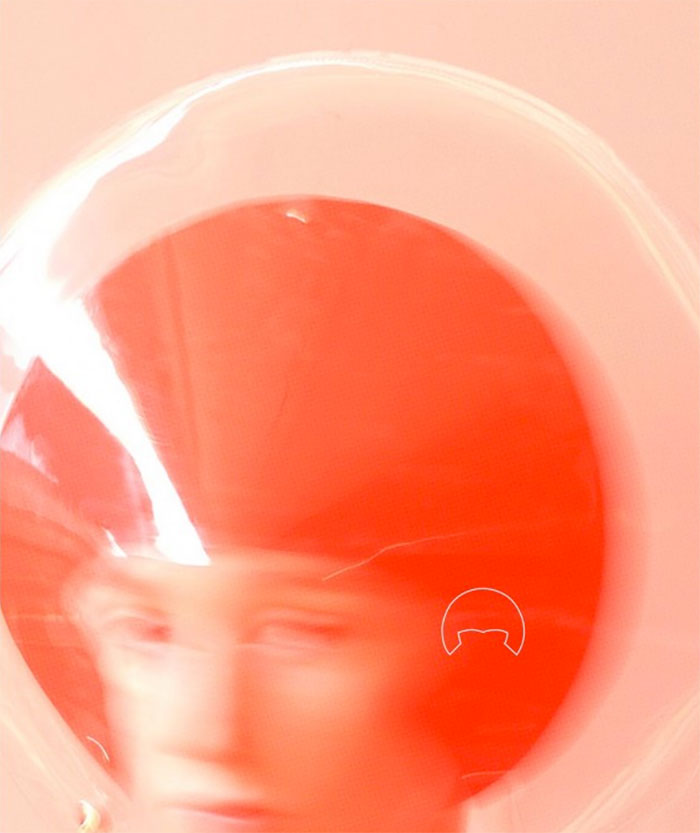
Tomihiro Kono is the hairstylist and author behind a self-published new book titled Head Prop: Studies 2013-2016. Throughout Kono’s career, his work has developed from solely follicular-based pursuits and into the realm of sculptural headwear. “What is most exciting for me is to create amazing visual photography,” he explains. “I find a lot of possibility in headwear design to broaden creative photography. I’ve always been inspired by historical design from all over the world: from masks, to religious dress and ceremonial dress – Geisha, for example. Using these references tells a story in the photography.” Kono goes on to cite the visionary Serge Lutens as another great influence on his work: “I respect him as a perfectionist. I especially like what he was producing between 1970-1980, when he was creatively directing the experimental commercial work for Shiseido. I hope to be like him and make creative work, constantly.”
It’s unsurprising, with this kind of work ethic behind him, that Kono has gone on to collaborate with some of the most revered names in fashion: from Jil Sander to Junya Watanabe. 2017 – ten years after he embarked on his career – felt like the right moment to release a publication outlining his creative processes. “I simply wanted to record a personal documentation of all the trials and errors of my creations,” he says. “These days many people use Instagram to record their work – I think it’s good if you want to use as a diary. But the work is going to disappear in the constant updates of all kinds of random information. Making and publishing a book by myself is like having a personal space to put together my archives. I am totally in charge.”
Head Prop is so extensive in chronicling Kono’s designs and inspirations – including unseen works made between 2013 and 2016 – that it feels a little like falling down a secret rabbit hole directly into Kono’s brain. “By revealing how I’ve developed my creations, I think it’s interesting for people to see how I work differently from other hairstylists and to see not only the final output but also the process of how I get to that point. Nowadays, what seems to be important is how you get a good result quickly rather than how hard you’ve worked and telling the story behind that. I find the working process hidden behind this just as interesting as the final result.” Kono releases the book on Friday in New York – the city he now calls home – and also intends to launch it Paris, London and Tokyo later this year. He also notes “I have started working on making wigs from scratch and that will be my next personal project.” Well, we can’t wait to see.
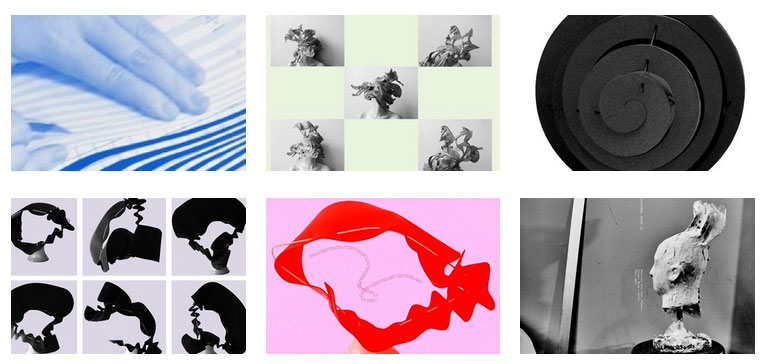
TOMIHIRO KONO THE MASTER OF HAIR
Tomihiro Kono started as a hairstylist in a small village in Japan, but now he is designing hairpieces in a city where most people can only dream about, New York. He worked together with several designers to create the most extravagant hairpieces for their shows and now he launched his book called Head Prop where he explains his design process. We had the opportunity to talk with this master of hair about his work.
Tomi Kono: A Headful Of Fantasy for Oyster #111
Wiggin’ out.
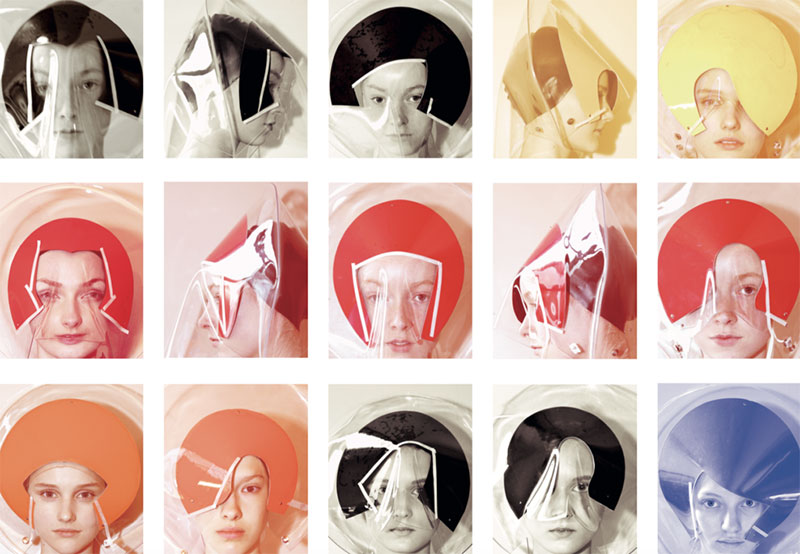
Tomihiro Kono might be a headpiece designer, but he’s not definitively in the business of accessorising. Rather, Junya Watanabe’s nine-time runway collaborator is intent on using his sculptural coiffures to build fully-formed characters — characters that are “thorough”.
Many of Kono’s head props are conceived at the juncture of fantasy (leisurely) and mathematics (laborious), revealing both blue-sky and meticulous processes. A cross-section of his CV reveals disparate possibilities: pierced leather in archetypal bondage style; Elizabethan era frivolity; the droll surrealism of René Magritte; and the follicular decisions of English new-wave band, A Flock of Seagulls.
Kono doesn’t dance near any preoccupation with the sparse and minimal. The Japanese artist offers a counterpoint that isn’t underpinned by the culture of aspiration — the stuff of beauty vloggers and Instagram tutorials. He’s interested in the spectacle — which on the runway is most often relegated to the body and the garments — and a sweeping cohesion that corporate marketers might tout as the 360-degree brand experience. Jargon notwithstanding, Kono says, “Hair design takes such an important role in making complete characters and to give a certain impression to the viewers. Building a thorough character is something I’m so into, especially when I work with brands with strong concepts and aesthetics.”
Welcome to the stage, Junya Watanabe: a man deeply entrusted to the realm of theatrics. When Kono engineered head props for Watanabe’s Fall/Winter 2015 presentation, their debut collaboration, I’m certain spectators hypothesised about Watanabe’s foray into headwear — so fluid was the affair. Kono’s work up top serves conceptually rather than clinging passively on, making him relatively peerless in his practice.
“I was free to propose whatever I liked and [Watanabe] either chose the best of my proposals or we discussed and evolved [the ideas] as we went,” he says of their work together. To round out Watanabe’s offerings — a feast of excruciatingly laboured pleats and folds, and serrated reptilian silhouettes — Kono seemed to reference semi-stretched accordions and the preposterous guard hats of Buckingham Palace. At times the headpieces resembled shark fins: charred, fanned out in perfect ovals that jutted very far into the wearer’s peripheries. Elsewhere, it was a spherical structure: very large and manifold, best visualised as an oversized origami rose fringing the circumference of the wearer’s face and almost, but not quite, obscuring her view. For his final trick, Kono diluted the conceptual quality, dressing heads in permutations of a short inky asymmetrical wig.
Onlookers might wonder — distressed or incredulous — about the materials involved in Kono’s head props, extending warm regards and well wishes to the necks of his models. Surely the more elaborate ones are not easy to hold up?! To sidestep injury and other site-specific concerns, he confirms extensive planning phases: “I had to consider long, strong, bendable materials to create the beautiful layers of arcs. They also needed to be light to stay on the head and thin so that they could be bound at both ends with metal screws.” For the frenetic toggling between looks — on-off-in-out-over-under-through —add “easily attachable and detachable” to the checklist of non-negotiables. The numbers involved in such precise preparations, however, are the sort of punctilious calculations that are irksome for a person with limited fluency in geometry— “I am not so good at math,” he admits.
The craft of head prop design is very different to the craft of, say, orange farming (you guessed it! Or you didn’t?!) — a fate that was very nearly sealed for Kono. But instead of inheriting his father’s business, he picked salon hairdressing “because I thought it was a cool job” he explains simply. He moved increasingly into synthetics, quickly accumulating a plump resumé of work that was bound up in a self-published book earlier this year: Head Prop 2013-2016.
It could have easily been just a glossy coffee table book — there are enough alluring images. Rather, it’s a (still beautiful, still glossy) record-keeping object, documenting the swings and roundabouts of Kono’s highly procedural career. It’s a blueprint-cum-journal featuring nearly every creation he has fashioned during that period. It’s like climbing into his middle mind: trace the tracks of clear bubble helmets enclosing cartoon-like 2D wigs (paper, plastic), black swathes punctured with gaping holes, falling about heads and bodies (ethylene and vinyl acetate), and buoyant structures in coalescent primary colours (papier-mâché). It’s big futurism with one eye on the past.
The swirling of old and new feels very true to the land Kono hails from. The merciless innovation of Harajuku, for example, versus the tiny village of Ehime in Japan’s south, where Kono grew up. “[There are] mythical legends that I got so much influence from as a kid. We have rituals to pray for the Sun Goddess (Amaterasu Oomikami), wishing for big catches for fishermen and good harvest for farmers,” he explains. “It’s a big event, a unique tradition of my tiny hometown. I had to dance all day long to pray when I was six.”
Exhausting but impressive, diligent but childlike: the same as his fantastical head props.
Words: Melissa Kenny
Images: Courtesy Tomi Kono
IRENEBRINATION> October 05, 2017
The Weird and Wonderful World of Architecturally Mathematical Hairstyles: Interview with Tomihiro Kono
When you see a fashion show your mind naturally focuses on the clothes and accessories on the runway. Makeup and hairstyles are other important aspects, but, quite often, they become secondary elements and in reviews they get neglected in favour of a description of the space where a show is taking place or a mention of the best-dressed celebrity sitting in the front row. Yet this rarely happens when the hairstyle in a show is created by Japanese-born, but New York-based Tomihiro Kono (河野富広).
A visionary master in the art of hairstyling, who developed an intriguing mix of traditional techniques combined with the most modern moods captured in the vibrant cities where he has lived, Tomihiro Kono has worked for different designers, including Jil Sander and Junya Watanabe.Hairstyles designed by Tomihiro Kono go from geometrical foam sculptures to vinyl circles dynamically surrounding the heads of the models like futuristic halos. The models wearing them could be considered as punk Alice-like characters lost in space rather than in the proverbial Wonderland.
A few months ago Konomad Editions published the volume Head Prop: Studies 2013-2016 (distributed internationally by Idea Books), that could be described as a compendium of Tomihiro Kono's creations and an introduction to his modus operandi.
Photographs, sketches and photo grids in the volume show his passion for forms (such as circular shapes and lines), materials (ropes, wire mesh, felt, plastic bottles and rubber tubes...) and avant-garde experiments with hair.
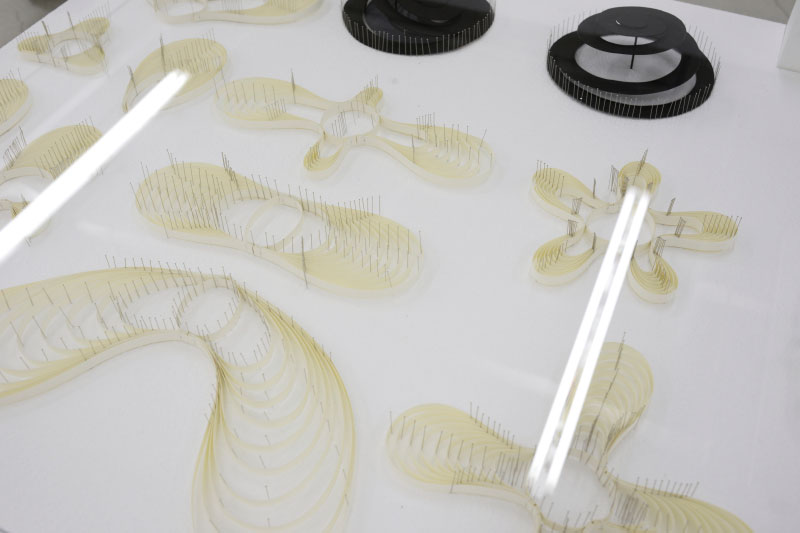
THE STUDY OF NEW HEAD DESIGN @ galley (Place) by Method
Tokyo August 2017 © konomad
The background reasearch included in the book proves that Tomihiro Kono's practice is suspended between mathematics, geometry and architecture, and sprinkled with childish glee.
The author of Alice in Wonderland, Lewis Carroll, was a writer with a powerful imagination, but also a mathematician and logician; Tomihiro Kono, the father of modern Alice characters in a punk wonderland, is an artist and a hairstylist playing with mathematical and logical principles. You can bet we will soon find him collaborating with a major artist or architect.
Head Prop features a very intriguing documentation about your work: why did you decide to publish it only now and how long did it take you to compile all the material you had?
Tomihiro Kono: The reason why I decided to publish the materials in a book format is that, as first thing, I wanted to document what I had worked on and had kept as a record for myself. Secondly, I thought that revealing my secrets - that is the stages of my creative process - would have been inspiring for all sorts of people and not just for those ones working in the fashion industry. I also wanted to expand my personal boundaries: taking the book on the road through exhibitions means getting the chance to meet new people, and even find more creative possibilities and collaborations with individuals working in other industries. My partner Sayaka and I worked on this book design for a year, we did a lot of editing, adding texts as well, and I genuinely hope that Head Prop will be inspiring for readers even in ten or twenty years' time.
Some creative people do not like revealing their modus operandi or background researches, but you willingly take readers behind the scenes of your work, what prompted you to do it?
Tomihiro Kono: I used to hide my process and background researches because I thought that in that way I was protecting my originality. However, now I'm positive about sharing my background researches with my readers. I think that, to keep searching for a new style, I must release what I have done. This is my past archive anyway and I don't think I should hang on what I have done in the past too much! Besides, if I hadn't published these projects I would only remember them roughly and that would be a shame considering the time and effort that went into those creations. Last but not least, the book format allows me to share my creativity and protect my copyright, so releasing this volume at this stage of my career makes perfect sense to me.
In the book you show us many inspirations behind your projects – where do you usually go to get inspired - museums, libraries or the Internet? Or do you have a favourite artist/art movement or architect you often go back to for ideas?
Tomihiro Kono: My inspirations can be found in many differemt places, I go to museums and libraries, but not so often. I guess nowadays I use the Internet more and look at photography of artists' studios. I also get inspired by documentary films. Surrealism, Dada, Bauhaus and Fluxus - very energetic movements - are my favourite ones. The academic approach of Bauhaus was one of the inspirations when making my book.
The late Vidal Sassoon once told me in an interview that the Five-Point Geometric Cut was based on different ideas and concepts, including the Bauhaus and architecture. Your work clearly displays links with disciplines such as art and architecture, but also mathematics and geometry, can you tell us more about them in connection with your work?
Tomihiro Kono: I developed my career as a hairdresser and a hairstylist, so I didn't specialize in architecture or graphic design, but I learnt all the haircut techniques at the Vidal Sassoon salon. The way they worked on hair was mathematical and logical, so each hairstyle is perfectly calculated to be made. I learnt there that there is a hair diagram to design hairstyles and an accurate work was needed to create a complete hairstyle, for example you must take into consideration which angle you are pulling the hair strands out to create the form that you want. There are haircuts called "geometric cuts", so they consider hair as regulated by geometrical and graphic principles. I therefore think that these mathematical connections in my work come from my haircut training.
Which is your favourite section from the book and why?
Tomihiro Kono: The diagram of systematic process and artistic process at the beginning of the book. This was the first time I analyzed how I proceed with my work and found out that I have two different processes. The diagram tells the readers that my process of hair design is somehow connected with other disciplines - such as architecture, design and products.
What's the most unusual material you have used so far for your hair pieces?
Tomihiro Kono: I would say iron sand, I used it to design a moving beard. It was kind of exciting to experiment with it. I often try to express the concept of hair using other materials.
You did two exhibitions in Tokyo in August: what did they feature, images from your book or also your materials and sketches?
Tomihiro Kono: In "The Study of New Head Design" at Gallery Place by Method in Shibuya, I exhibited posters of different head prop design variations and some paper prototypes; in the other for the bookshop POST, I showcased real head props as an installation - they were not on mannequins but arranged in modern displays. It was good for me to have two places at once as one complemented the other and visitors got a complete vision of my work by checking out both spaces.
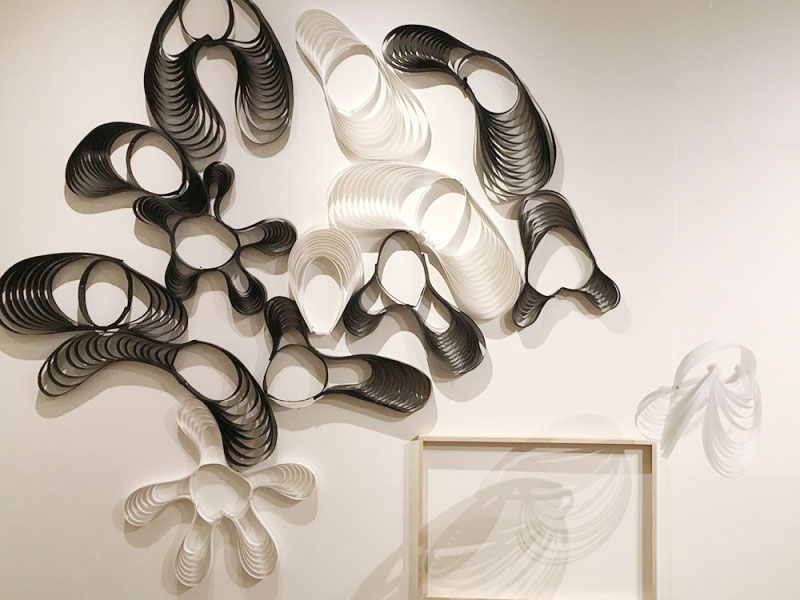
THE STUDY OF NEW HEAD DESIGN @ bookshop POST, Tokyo
August 2017 © konomad
10 Magazine > 1st April, 2017
Tomihiro Kono To Release First Book ‘Head Prop’
When it comes with items with which to adorn the uppermost part of the body – Tomihiro Kono, the Japanese-born, New York-based hair stylist-cum-headpiece artist is the master. He’s the man behind Junya Watanabe’s incredible headpieces, as well as collaborations with just about everyone worth knowing in the fields of art, fashion, music and performance. Not mentioning his creations frequently appearing in many an issue of our very own fashion bible. His work draws influence from the early 20th century Dada movement, as well as assemblage expressionism (think: Robert Rauschenberg), creating headpieces that are entirely unique. And now, Kono is releasing a brand new book all about his incredible career, from his time as a classically trained hair-dresser in a tiny village in Japan, through to archived collections of his world renowned head prop designs. There’s even some unseen works. Juicy! The new book, ‘Head Prop’, is apparently the first on the subject (who knew?), and will be published on April 1st with a launch to follow at the Office Magazine newsstand in New York on the 7th. For the real jet-setters amongst you, Kono also has his own exhibition opening at the Place by Method gallery in Tokyo, from the 2nd to the 26th August.
‘Head Prop’ will be available for purchase between 7th and 14th April at Canal Street Market, NY and online at konomad.com
Distributor: Idea Books, ideabooks.nl
INFRINGE> 19 April, 2017
Hairstylist and head prop extraordinaire Tomihiro Kono reveals the inspirations behind his new book
“Head props are pieces of transformative and wearable art. I don’t see them as headpieces used to decorate hair but as a way of creating one-off characters.” – Tomihiro Kono
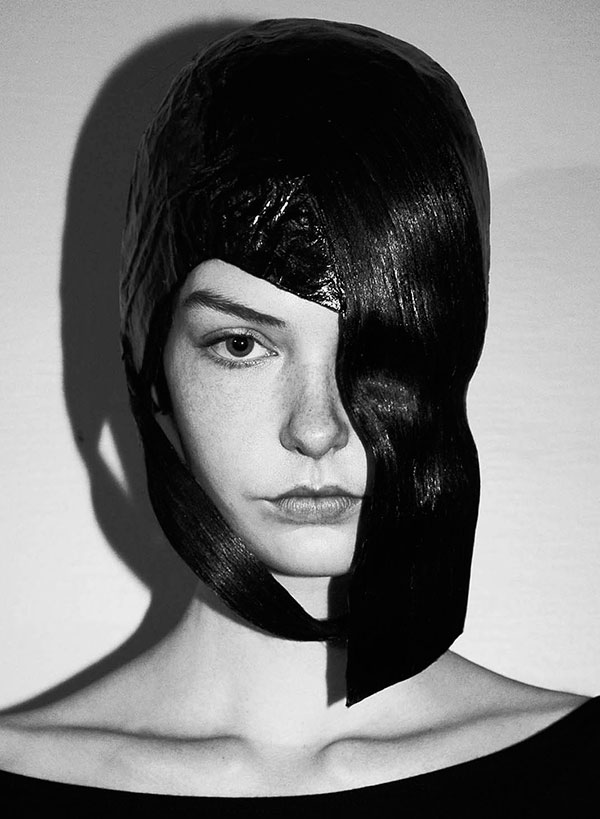
Junya Watanabe AW 2014
Beginning his career as a classically trained hairstylist, Tomihiro Kono’s work no longer begins and ends in the salons of Tokyo. Instead, the Japanese creative’s designs are used by designers and stylists worldwide to transform both editorials and catwalk shows. Kono frequently contributes to titles including W Magazine, Numéro and Harper’s Bazaar, as well as working with designers such as Jil Sander and Derek Lam. His longstanding collaborative partnership with designer Junya Watanabe (Kono has created pieces for the shows since 2014) has made him a recognisable force within the fashion world.
Kono moved to London in 2007, where he swapped salon-based hairstyling for session work. This is when he began to experiment with the creation of head props, “I developed so many creative, inspiring and supportive friendships there, which helped me to develop my creative mind” he explains. “The energy, youth culture, music and fashion is so original and cool. Every collaboration I did in London was so vibrant.” After 5 years in London, Kono moved to New York, where he is based today. Here, his approach to designing head props has become increasingly mathematical and methodological. Stylistically, his pieces have become very graphic and distinctive, with Kono incorporating a diverse array of materials into his projects, including vinyl, rope, iron sand, rubber tubing and visual motion effects.
Kono’s first book, Head Prop: Studies 2013–2016, showcases the sheer range of his creative capabilities. Released this month, the book demonstrates how he transforms his ideas into malleable 3D objects. It also represents another notable career shift for Kono as he sets up the Brooklyn based independent publisher Konomad, whilst simultaneously branching out into wig making. INFRINGE spoke to him about the concept behind his new book.
What inspired your move from hairdressing towards head prop artistry?
I actually still consider hair styling as the main part of my job despite having made many head props. Ideally, I’d like to create a balance between them as one stimulates the other. When I moved to London in 2007 it felt really natural to start creating head props – I felt creative and saw this as a way to build my career in my own, original way. I’ve always thought that originality is extremely important when working freelance, as you want people to recognise that you can make something special and unique. Eventually people started to ask me to make exclusive pieces for shoots and to be part of exciting collaborations with artists and performers.
Does your background in hairdressing influence your approach to creating head props?
Yes, definitely. The techniques used are almost inseparable. They are always related to each other. For example, I’ve made a series of 3D hairstyles inspired by the haircut diagrams I used during my hairdressing training in Tokyo. It’s essential to know how each hairstyle is structurally made so you can control the hair shape and line.
Which materials do you most enjoy working with?
Having experimented with lots of different materials I find hair the most interesting one to work with. Hair is a responsive material, easily affected by weather, humidity and change of environment, which makes it both profound and challenging. When I am on set, I try to constantly adjust the hair as the photographer shoots as even minor changes in hairstyling can transform a photograph. In my personal opinion, there’s also something relaxing about touching hair.
Your new book Head Prop: Studies 2013–2016is comprised of diagrams, sketches and photos. Why did you decide to present the book in this way?
I wanted my book to inspire as many people as possible, which is why I adopted both a graphic and educational approach inspired by Typology. I like that the book doesn’t look like a hairstylist’s work at first glance as I think this allows for the content to reach a wider audience. There was something very satisfactory about organising the images into a grid-like system as it gave the book an unemotional quality where the results are objectively recorded, like a catalogue.
What made you decide to compile this book, a retrospective from 2013-2016, now?
I started the book in April last year as a personal documentation of all my experiments and the trials and errors of my creations. I had spent so much time and effort on the pieces that I wanted to keep a record for myself and the rest of the world. There is always some work that remains unseen as it has no place to go, so I wanted to make a place for them to be shown so I wouldn’t forget what I’d made. Books are my favourite medium to record and archive, I’ve always believed in analogue mediums rather than digital. I hope that upcoming creators or next generations will have a chance to dig out my book someday, just like I have done with old haircutting and styling process books.
What is your most unlikely source of inspiration?
Daily life is my inspiration. It’s all around us if you want to see it.
Credits
Interview Alex Mascolo
Images Sayaka Maruyama © Tomihiro Kono
Special Thanks Tomihiro Kono Website tomihirokono.com
DOCUMENT JOURNAL> Thu, April 13, 2017
Tomihiro Kono’s Hair Sculpting Process
By Michael Beshara
Junya Watanbe, Rei Kawakubo’s protégé, first summoned Tomihiro Kono to collaborate on his Autumn/Winter 2014 runway collection. Years later, Kono, a master of experimental coiffure-making, has evolved from stylist to artist-at-large, creating an oeuvre of multidimensional head forms that display logic order in the most beautiful fashion. On the release of his self-published research monograph, “Head Prop: Studies 2013 - 2016,” Kono reveals his fascinating appetite for mathematical discovery, a practice he realized at the start of this period in order to craft beauty from form.
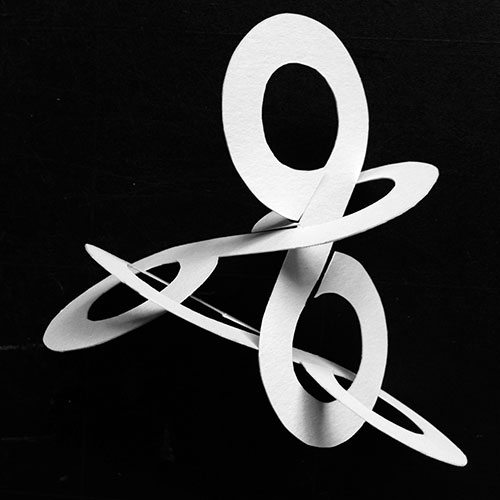
Michael Beshara—What emotion best describes your work?
Tomihiro Kono—Surprise: I hope my work is surprising for people; ideally, I want to be surprised by what I have made, too.
Michael—How have you embraced hair specifically as an artistic practice?
Tomihiro—I have worked as a hairstylist for over 20 years. Hair is such a mysterious material to work with. The fact that it is living—meaning it is part of nature—is something I cannot control enough. Different types of hair and textures keep me sharp! Its condition is easily affected by the weather. I have also started making wigs, which keeps me busy—to make them from scratch is my next challenge. I need to acquire new techniques such as sewing and knitting. I've always consider myself a hairstylist rather than a head prop artist.
Michael—How has ascribing to mathematical orders given dimension to your artistry?
Tomihiro—Most of the designs I make are based on the mathematical process that is revealed inside the book. [The idea] was a transformative one, because it changed how I selected materials and developed structure. The final product, as a result, can be closely related to that of graphic design. Thinking back to my time as a hairdresser, we used mathematical sequences such as 3D haircut diagrams to understand how to divide and pull out panels in the creation of particular styles. The head props that I have created [since 2013] are based on planning. As mentioned in “Head Prop,” there are mainly two types of creative processes: planned and artistic. Hair design is counted as the latter. To meet accidental design is the exciting part of it. I first start with research, which leads to the initial design and selection of materials; then a redesign for resize and quality improvement before completion. This way is practical. When you work as a team, you have to make head props size-adjustable.
Michael—Tell me about your experience collaborating with Junya Watanabe?
Tomihiro—I had dreamed of working with Comme des Garçons for a long time: It was in the beginning of 2014 when [Watanabe] asked me to collaborate for his then-upcoming Autumn/Winter 2014 collection. I felt so honored.
Michael—What is required of you to create your “characters”?
Tomihiro—Making a character for me means making a concept, which I find the most exciting in the whole process. I do a lot of research for inspirations, mostly found pictures. Nowadays you can search for any sort of images online. Amazing! I also visit libraries; I tend to read books from genres that normally disinterest me. For example, I was not so into Pop art, Minimal art, or graphic design-related books before 2014, but since then I have started to adopt their essences into my work. American art was quite new to me after moving to [New York] from London and Paris.
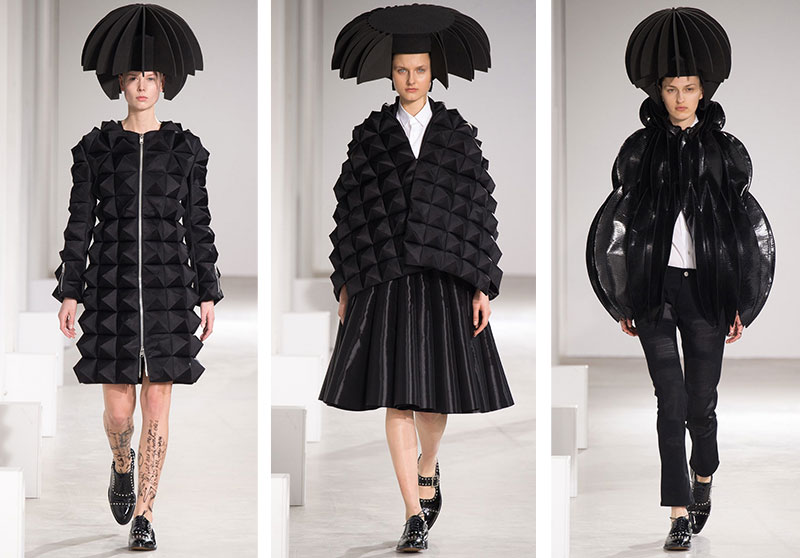
Junya Watanabe AW 2015 © ︎Vogue
Beshara—London was where you first began making head props?
Tomihiro—London was influential in so many ways. I loved the antiques that I rarely encountered in Japan. I used to make head props inspired by found materials in those days. I once made feather pieces with real feathers of birds I picked up from park grounds.
Michael—Your work is almost gothic; religious in its control, conceptual, yet you create with a childlike freedom, making pieces with a lot of wit and humor at the same time. How do you achieve that?
Tomihiro—The most essential thing is to be curious. It’s good to be easily influenced if you can reflect the influence in your style, in your work. I like to have both childlike freedom of imagination and professionalism at the same time.
Michael—To what extent do you self-edit? Is it important in your creative process and how this book reveals your way of artistry?
Tomihiro—For this book, I wanted to unveil my working process and works that have not yet been seen—the things that are not usually exposed to the public and my creative process of making them. My partner, Sayaka, and I are self-publishing it [under the nomenclature] Konomad Editions. We discussed making this book look educative, design-related. The format is so important to visualize our ideas and she did most of its design. It was important for me to take the responsibility of my work and be in the position to oversee and direct how the archive was compiled. It was a new challenge as we had so much to edit—pictures, texts, archives—it took us one full year to complete, but we feel [now] that we have done a good job. I’ve always liked books. I like going to secondhand bookshops in whatever cities I visit. You can feel the textures and taste in books, which I love.
Michael—“Head Prop” is easy to read, highly informative, pictorially driven, and methodical in its flow. In what ways is it a reflection of your own work?
Tomihiro—You might ask why I exposed so much in the book: I thought it would be interesting for people not only in the fashion industry to see how a single hairstylist could venture into creation as an individual. At first glance, it does not really seem like a hairstylist’s work, which is actually what I do as a job. The book fully reflects my history, archive, and trial and errors. It is my personal research that I’m sharing with the world.
Michael—How do you maintain the integrity of your work, which you refer to as “anonymous design” in the book?
Tomihiro—I came across this idea through the amazing graphic and product designer Sori Yanagi in Japan. When I discovered his work, I realized that I wanted to share his thought: It is what I wanted to achieve with my head design practice. But I cannot describe my design as “anonymous design” until people say that it is. For work to be considered “anonymous design” people need to render it timeless, high quality, and beautiful. That can take over a generation.
OFFICE magazine> March 31, 2017
Tomihiro Kono Book Launch
Hair and head prop artist Tomihiro Kono is launching his archival book and limited edition poster at the office newsstand on Friday, April 7th. Head Prop is a documentation of his design work from 2013-2016, and the book clearly shows Tomihiro's innovative, uncompromising work. Having developed a highly successful international career as a session hair stylist, here Tomi ventures into new territory. He's not only attempting to produce visually striking head designs, but work that focuses on functionality without sacrificing overall beauty.
Tomihiro Kono started his career as a classically trained Japanese hair stylist. His passion soon lead him to begin exploring more creative hair and head designs. Since 2013, when Tomi moved to New York, he has regularly shot for the likes of various editions of Vogue, Interview, W, and V.
We also did a little Q&A with Tomi. Scroll down to learn more about him.
Text by Ivan Guzman
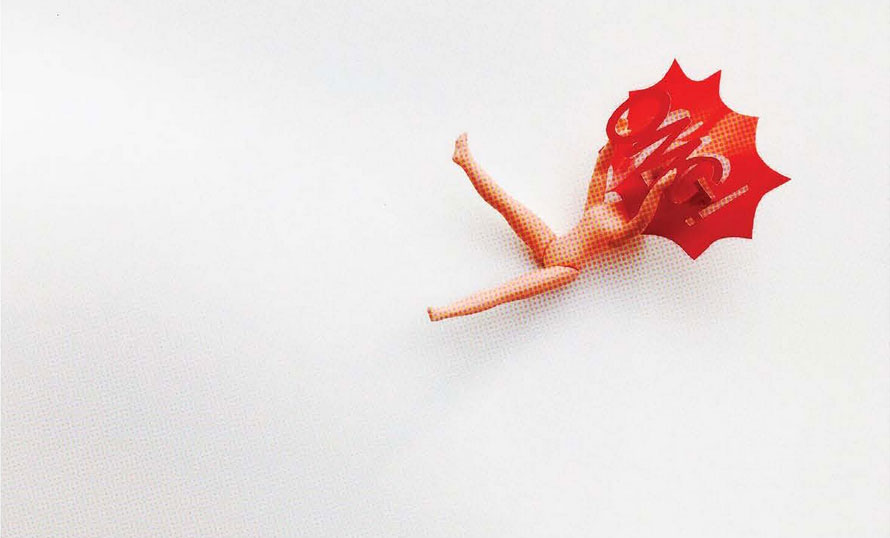
There are many different types of head art that you do. Could you tell me about these?
For me, it’s interesting to make different types rather than making a similar kind of design over and over again. I try not to categorize what I make. I just randomly get inspired from different things, and my interests changes from time to time. I learned traditional Japanese Geisha hair dressing before moving to London. I enjoy a variety of styles related to hair.
How do you merge being a hairstylist with being a head prop artist? What skills transfer over?
In the beginning of my career, I started making head props to broaden hair & head expressions as a hair stylist. To fully satisfy my creativity and a passion to pursue my originality was a starting point. Being a hairstylist and a head prop artist means that I have more options of head designs. When people need my creativity for a collaboration, I believe we can bring out something conceptual and strong in us together. Since I like photography more than anything, I always think about creating a strong visual image that inspires people.
Run through your creative process with us. What are the steps in coming up with one of your head props?
There are 2 ways: a systematic process for mathematical designs & a more artistic process. For the mathematical designs, it goes like this: 1) Idea research 2) concept 3) planning 4) material selection 5) making prototypes 6) material selection 7) resize 8) redesign 9) overall improvement (design development) 10) model size fitting 11) completed. The artistic process involves more intuitive and freehand styles.
How did moving from London to New York impact your creative process?
Moving from one city to a new city inspires me a lot. I felt the creative vibe in London most, so I created so many head props. Since moving to New York, I am more into hair and wig making for a variety of nationalities. I have a lot to learn from New York.
When do you know that a head design is “done”? I imagine that it can be hard sometimes to stop adding layers and layers.
I try to look at the head design objectively while making it, trying to avoid the head prop becoming too personal and too much in terms of design. I think carefully about the balance and materials I use and what kind of impression the design will give to the viewer when it’s a collaboration and there is a concept.
Has your Japanese culture influenced your hairstyling and/or head prop art in any way?
Yes. I’ve made a Geisha inspired hair portrait series, which was featured in Eyemazing Magazine in 2010 and Japanese Mage (Samurai hair-style) inspired wigs for a men’s fashion show. I studied classic Japanese hair dressing, and that’s definitely one of my signatures.
What do you hope people take from your head art?
Hopefully what I create is something inspiring for people.
I know your head props have found their place in high fashion/runway already, but looking at them, I personally think that they could find a place on drag queens, performance art, etc. How do you think the emerging head prop movement, which you pioneered, could potentially make its way into the mainstream?
I think it depends on the changing trends. For me, it seemed like head prop movements were in the mainstream when I was in London back in 2008-2011. I felt people were really passionate about head props, and lot of stylists were looking for creative masks and head pieces. Recently the trend worldwide is more natural, so hairstyling is relatively natural-looking. What people want tend to change from time to time, so there’s always a chance for the emerging head prop designers to be under the spotlight.